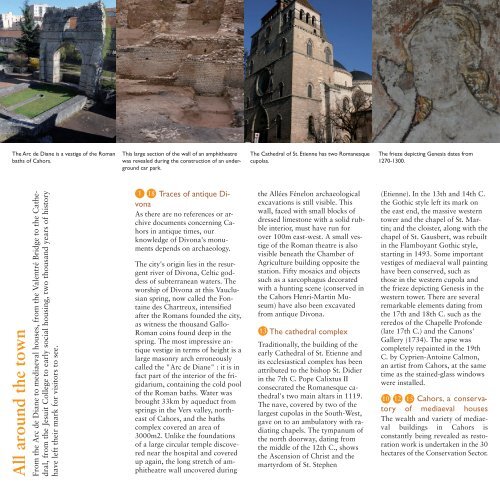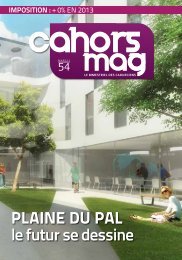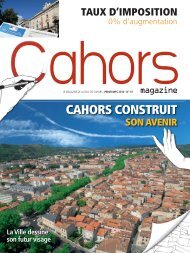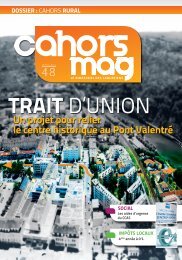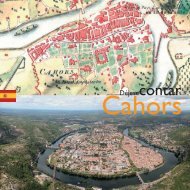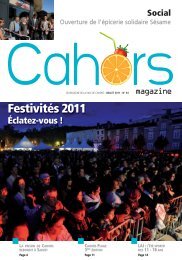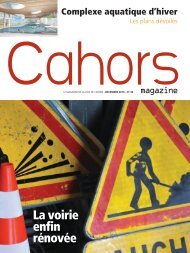The Arc de Diane is a vestige of the Romanbaths of <strong>Cahors</strong>.This large section of the wall of an amphitheatrewas revealed during the construction of an undergroundcar park.The Cathedral of St. Etienne has two Romanesquecupolas.The frieze depicting Genesis dates from1270-1300.All around the <strong>to</strong>wnFrom the Arc de Diane <strong>to</strong> mediaeval houses, from the Valentré Bridge <strong>to</strong> the Cathedral,from the Jesuit College <strong>to</strong> early social housing, two thousand years of his<strong>to</strong>ryhave left their mark for visi<strong>to</strong>rs <strong>to</strong> see.1 18 Traces of antique DivonaAs there are no references or archivedocuments concerning <strong>Cahors</strong>in antique times, ourknowledge of Divona's monumentsdepends on archaeology.The city's origin lies in the resurgentriver of Divona, Celtic goddessof subterranean waters. Theworship of Divona at this Vauclusianspring, now called the Fontainedes Chartreux, intensifiedafter the Romans founded the city,as witness the thousand Gallo-Roman coins found deep in thespring. The most impressive antiquevestige in terms of height is alarge masonry arch erroneouslycalled the "Arc de Diane" : it is infact part of the interior of the frigidarium,containing the cold poolof the Roman baths. Water wasbrought 33km by aqueduct fromsprings in the Vers valley, northeas<strong>to</strong>f <strong>Cahors</strong>, and the bathscomplex covered an area of3000m2. Unlike the foundationsof a large circular temple discoverednear the hospital and coveredup again, the long stretch of amphitheatrewall uncovered duringthe Allées Fénelon archaeologicalexcavations is still visible. Thiswall, faced with small blocks ofdressed limes<strong>to</strong>ne with a solid rubbleinterior, must have run forover 100m east-west. A small vestigeof the Roman theatre is alsovisible beneath the Chamber ofAgriculture building opposite thestation. Fifty mosaics and objectssuch as a sarcophagus decoratedwith a hunting scene (conserved inthe <strong>Cahors</strong> Henri-Martin Museum)have also been excavatedfrom antique Divona.13 The cathedral complexTraditionally, the building of theearly Cathedral of St. Etienne andits ecclesiastical complex has beenattributed <strong>to</strong> the bishop St. Didierin the 7th C. Pope Calixtus IIconsecrated the Romanesque cathedral'stwo main altars in 1119.The nave, covered by two of thelargest cupolas in the South-West,gave on <strong>to</strong> an ambula<strong>to</strong>ry with radiatingchapels. The tympanum ofthe north doorway, dating fromthe middle of the 12th C., showsthe Ascension of Christ and themartyrdom of St. Stephen(Etienne). In the 13th and 14th C.the Gothic style left its mark onthe east end, the massive western<strong>to</strong>wer and the chapel of St. Martin;and the cloister, along with thechapel of St. Gausbert, was rebuiltin the Flamboyant Gothic style,starting in 1493. Some importantvestiges of mediaeval wall paintinghave been conserved, such asthose in the western cupola andthe frieze depicting Genesis in thewestern <strong>to</strong>wer. There are severalremarkable elements dating fromthe 17th and 18th C. such as thereredos of the Chapelle Profonde(late 17th C.) and the Canons'Gallery (1734). The apse wascompletely repainted in the 19thC. by Cyprien-An<strong>to</strong>ine Calmon,an artist from <strong>Cahors</strong>, at the sametime as the stained-glass windowswere installed.10 12 15 <strong>Cahors</strong>, a conserva<strong>to</strong>ryof mediaeval housesThe wealth and variety of mediaevalbuildings in <strong>Cahors</strong> isconstantly being revealed as res<strong>to</strong>rationwork is undertaken in the 30hectares of the Conservation Sec<strong>to</strong>r.
N° 12 rue de la Daurade is one of the oldesthalf-timbered houses in the South of France.The pulpit of the church of St. Barthélémy is a fineexample of 17th C. church furniture.A statue of the Virgin and Child decorates the façadeof the church of St. Urcisse.The Valentré Bridge is the monumentwhich symbolises <strong>Cahors</strong>.Several hundred houses from the12th - 14th C., with widely varyingstyles and features, are still standing;from 13th C. half-timberedhouses such as that at n° 12, rueDaurade <strong>to</strong> the Chantrerie, a merchants'lodge of the 14th C.; frombourgeois houses with shop arcadesin the rue du Château du Roi <strong>to</strong> theDuèze and de Via urban palaces.The pragmatism, creativity andpower of the people of mediaeval<strong>Cahors</strong> are manifest in this host ofbuildings.These houses, composed of fourmain building materials : <strong>Cahors</strong> limes<strong>to</strong>ne,Figeac sands<strong>to</strong>ne, brickand wood, often still have visibleshop arcades on the ground floorand finely-sculpted windows on theupper floors. The rues Nationale,de la Chantrerie, de la Daurade, duChâteau du Roi and des Soubirousprovide a representative sample ofthe mediaeval houses of <strong>Cahors</strong>.16 St. Barthélémy ChurchFormerly St. Etienne des Soubirous,St. Barthélémy is one of the ten parishchurches within <strong>Cahors</strong> in theMiddle Ages. This big building inthe Southern Gothic style is flankedby a large bell-<strong>to</strong>wer-cumporchwith pointed-arch openingson three levels. Jacques Duèze wasbaptised there in 1244. After beingelected Pope, he ordered its reconstruction.Close by, his brother Pierrehad the imposing palace with itstall corner <strong>to</strong>wer built. In 1644, St.Barthélémy was attached <strong>to</strong> theGreat Seminary founded by the bishopAlain de Solminihac. Thechurch contains mediaeval wallpaintings, an interesting collectionof paintings dating from the 17th C.<strong>to</strong> the 20th C. and a wooden pulpitdating from 1663 made by the mastercraftsman carpenter BertrandRouzières of <strong>Cahors</strong>.6 St. Urcisse ChurchIn the Badernes quarter, this parishchurch founded in early times is namedfor a 6th C. bishop of <strong>Cahors</strong>.The present structure is the result ofseveral building campaigns datingfrom the 12th - 19th C. The centralnave is flanked by two side-aisles. Itis just possible <strong>to</strong> identify the presenceof the Romanesque portal decoratedwith billets on the southwall; it was no doubt abandoned inthe early 14th C. in favour of thelarge portal with arched mouldingsopened in the west front. This doorwaywith niches for statues at theside and rather summary foliate decorationframes a partially re-workedmediaeval statue of the Virginand Child.19 20 The Valentré bridge andsurroundingsIn the 14th C., three bridges spannedthe Lot in <strong>Cahors</strong>: the OldBridge, in the south, dating nodoubt from the12th C. (possibly onantique foundations) followed onfrom the mediaeval main street; the13th C. New Bridge in the east led<strong>to</strong> the Dominican monastery andthe Villefranche road; and the ValentréBridge in the west, the onlyone <strong>to</strong> survive, intended <strong>to</strong> serve anew quarter of the city. This iconicstructure was decided on by theConsuls in 1306, and work on itcontinued until about 1380. A listedHis<strong>to</strong>ric Monument since 1840, itwas res<strong>to</strong>red in a respectful mannerby the architect Paul Gout in the19th C.: he reinforced its militaryaspect, and had a small devil-figurecarved at the <strong>to</strong>p of the central <strong>to</strong>weras a reminder of the legend claimingthat Satan had a hand in thebuilding. It has three <strong>to</strong>wers, two ofwhich are fortified, and the slightlyhumped roadway is carried on wideGothic arches. It is the best preserved,most representative mediaevalfortified bridge in France.Upstream lies the Fontaine desChartreux, a resurgent river sacred<strong>to</strong> the Gauls and now the source ofall <strong>Cahors</strong>' drinking water. Featureslinked <strong>to</strong> river transport are still visible:the <strong>to</strong>wpath, weir and lock.The latter has walls with roundedends, indicating their 19th C. origin.Fifty metres upstream from thebridge, the former pumping stationfor the waters of the Fontaine desChartreux, Cabazat, has becomethe "Maison de l'Eau", where exhibitionsand activities on the themeof water and the Valentré Bridgeare held.


